Navigating the Dubai Metro: Insights and Map Guide
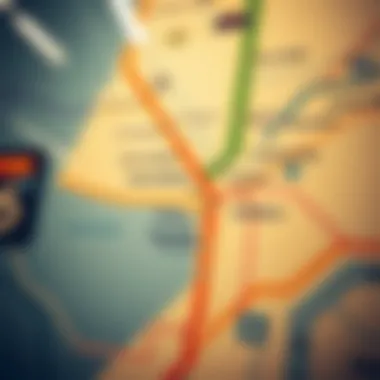
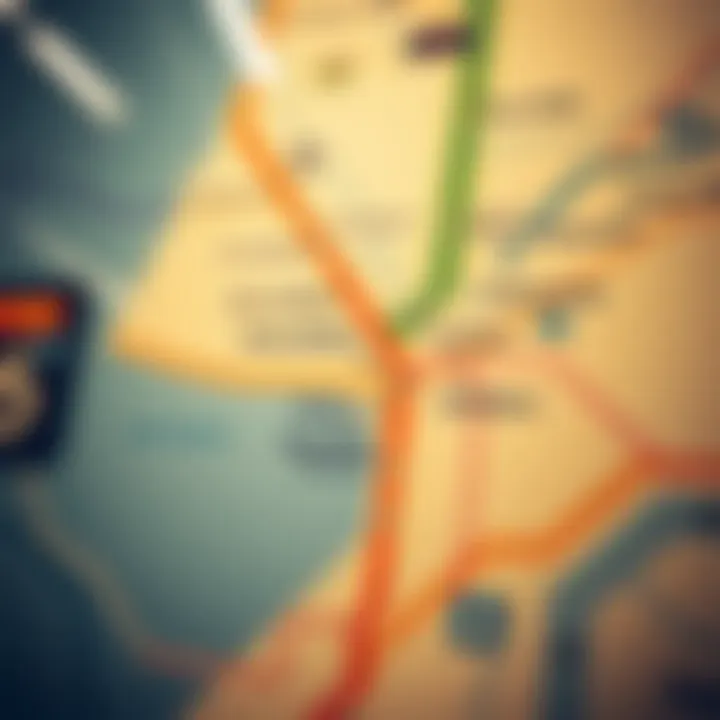
Intro
In the grand scheme of urban living, transportation plays a pivotal role, especially in bustling metropolises like Dubai. This city, known for its opulence and towering skyscrapers, is home to a sophisticated metro system that has transformed the way residents and visitors navigate the urban landscape. The Dubai Metro is more than just a mode of transport; it represents a leap towards sustainable living and efficient urban mobility. Through this piece, we aim to unravel the complexities of the metro system, providing a detailed map along with insights that could enlighten potential investors and those seeking to settle in this dynamic city.
As a lifeline for the city, the metro connects key areas, enhancing accessibility and encouraging a significant uptick in property demand along its routes. This article will explore the nexus between the metro's infrastructure and the real estate market, shedding light on current trends and economic factors influencing property prices. For those contemplating a move or investment in Dubai, understanding how to effectively navigate this system can yield beneficial advantages.
By the end of this exploration, readers will be well-equipped with knowledge that goes beyond mere familiarity with the metro itself. They will grasp its influence on urban development and have insights into practical usage, further aiding in informed decision-making for both residents and investors.
Prolusion to the Dubai Metro
The Dubai Metro is a key feature of the city’s infrastructure, which has gained significant traction as both an efficient transport option and a centerpiece of urban planning. As investors, homeowners, real estate agents, and analyst navigate the impressive growth of Dubai, understanding the dynamics of this metro system becomes crucial. This section lays the groundwork by exploring what makes the Dubai Metro noteworthy in today’s fast-paced urban landscape.
Not only does the metro system facilitate daily commutes for thousands, but it also plays an essential role in reducing traffic congestion, thereby improving air quality in the bustling metropolis. Rather than grappling with the challenges posed by road travel, residents can enjoy a more reliable and quicker transit mode. The integration of the metro within the city’s plans also suggests the forward-thinking approach the authorities take towards infrastructure and sustainability.
Overview of the Metro System
The Dubai Metro began operation in 2009, and it currently encompasses two main lines: the Red Line and the Green Line. The Red Line is particularly notable, as it stretches from Rashidiya to UAE Exchange and has several major stations serving important areas like Dubai Marina, Burj Khalifa, and the Mall of the Emirates. The Green Line, meanwhile, connects the city’s historic areas with growing districts, promoting accessibility.
Riding the metro provides a glimpse into the city’s modern architecture and, more importantly, is a cost-effective solution for getting around. Travelers can make use of the Nol card system, which allows easy ticketing and fare payments, ensuring a hassle-free experience. The system operates seamlessly, with screens updating passengers in real-time about services and schedules.
Through a strategic plan, the Dubai Metro aims to connect various sectors of the city, including educational institutions, healthcare facilities, and commercial spaces. Efforts to continually update and expand the network indicate an ongoing commitment to improving public transport accessibility, serving as a backbone for the urban layout.
Historical Context
The roots of the Dubai Metro trace back to the city's aggressive drive for advancement and modernization in the late 20th century. As Dubai transitioned from a modest coastal town into a global hub, the rapid surge in population and economy necessitated the exploration of efficient transportation methods. In 2005, the Dubai government inaugurated the Dubai Roads and Transport Authority (RTA), which laid out a grand vision for the metro system.
Construction commenced in 2006, with a fast-track approach to meet the increasing demand. The successful opening of the Red Line in September 2009 showcased the potential of a modern metro system amidst the backdrop of skyscrapers and vibrant city life. By 2011, the Green Line unveiled additional coverage, further connecting pivotal areas and contributing to the city's expanding urban landscape.
Today, the Dubai Metro stands as an icon of innovation and a testament to strategic urban planning, boasting the world’s longest automated metro system. The foresight exhibited in its development paved the way for an integrated urban transport network. The narrative behind its inception and evolution enriches its significance as a vital piece of Dubai's story, marking the city’s evolution into an internationally recognized metropolis.
"The Dubai Metro is not just a means of transport. It is a symbol of what a city can achieve with vision and determination."
By understanding the integration, efficiency, and evolution of the Dubai Metro, you begin to grasp its essential role in Dubai’s identity and future.
Metro Stations Mapping
Mapping the metro stations is a vital component of understanding the Dubai Metro system. This section lays the groundwork for comprehending how this urban transportation marvel operates, showcasing its efficiency and coverage in a growing city like Dubai. A thorough grasp of the station layout not only aids daily commuters in navigating the system but also enlightens potential investors and homebuyers about key locations well-served by public transport.
The map serves several essential functions:
- Visual Representation: It offers a clear visual guide to the metro’s routes and stops. This can be particularly valuable for new residents or tourists unfamiliar with the city.
- Planning and Accessibility: Understanding the location of stations is crucial for planning daily commutes. For instance, knowing that the Burj Khalifa/Dubai Mall station is close to one of the city’s main attractions makes it easier to structure a day out.
- Commuter Convenience: The efficient layout of the metro system allows easy transfers between lines. A well-mapped network can substantially reduce travel time.
Main Lines of the Metro
The Dubai Metro comprises two primary lines: the Red Line and the Green Line, with extensions planned for the future. The Red Line runs from Rashidiya to UAE Exchange, covering several vital areas, including the airport, shopping malls, and business districts. Meanwhile, the Green Line connects historical districts such as Deira and Al Jafiliya, ensuring that both business and cultural sites are well connected.
Each line has its own unique benefits:
- Red Line: This line serves as the backbone of the metro, embracing the commercial heart of Dubai. Notable stops include Dubai Marina and the Mall of the Emirates.
- Green Line: This offers access to more traditional neighborhoods and the Dubai Frame, reflecting the city’s duality of modernism and heritage.
Detailed Station Descriptions
Each metro station has its own character and serves different demographics, making their descriptions essential for both commuters and investors. Let’s break down some of the stations that form the backbone of the metro experience:
- Burj Khalifa/Dubai Mall Station: This is perhaps the busiest station owing to its proximity to the world's tallest building and a premier shopping destination. It attracts tourists and locals alike, contributing to the hustle and bustle of the area.
- Dubai Marina Station: Located in a vibrant district known for its nightlife and leisure activities, this station caters mainly to residents and tourists, enhancing the connectivity of this luxurious area.
- Al Rigga Station: This stop is in the older part of the city, providing access to various local shops and eateries, embodying the cultural essence of Dubai.
- UAE Exchange Station: Serving one of the major metro terminals, this station highlights the significance of transportation in facilitating trade and financial activities in Dubai.
This understanding of metro stations not only elevates an individual's daily commuting experience but serves as a powerful indicator for real estate and investment opportunities.
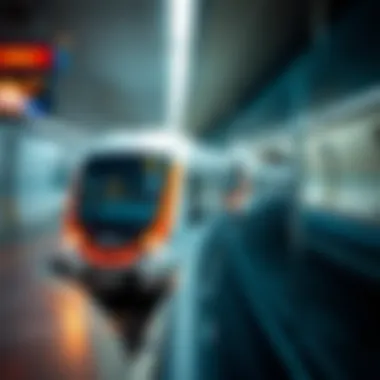

By knowing which metro stations are in the pipeline, investors can position themselves advantageously in the fast-evolving real estate market of Dubai.
Significance of the Metro in Urban Planning
The Dubai Metro stands as a remarkable feat of engineering and urban strategy, shaping the way residents and visitors navigate this bustling emirate. Its significance in urban planning cannot be overstated. By providing an efficient and reliable mode of transport, the metro fundamentally transforms urban mobility, connecting key areas and influencing the daily lives of its users.
Integrating Public Transport
One of the cornerstone elements of an effective urban transport system is seamless integration. The Dubai Metro exemplifies this by synchronizing with various transport modalities. Buses, taxis, and even tram services are designed to work in harmony with the metro lines. For example, major stations like the Burj Khalifa/Dubai Mall station are positioned to facilitate easy transitions between different forms of transportation. This thoughtful integration not only streamlines commuter movement but also reduces traffic congestion, a growing concern in urban environments.
Moreover, the accessibility of the metro encourages a shift away from private vehicle use, fostering a more sustainable urban lifestyle. As individuals opt for public transport, emissions decline, contributing positively to the overall environment. Additionally, this approach potentially alleviates the urban heat island effect commonly seen in cities that are highly dependent on automobiles.
Impact on Land Use and Development
The Dubai Metro has dramatically altered land use patterns across the city. Areas surrounding metro stations have witnessed a boom in development, with residential and commercial projects sprouting up like daisies after rain. This phenomenon is rooted in the concept that proximity to mass transit can significantly raise property values. For instance, neighborhoods close to the metro have experienced an uptick in demand, making them attractive to both investors and potential homeowners.
As property prices soar, planners and developers have been compelled to rethink spatial layouts and urban design. Mixed-use developments, which combine residential, retail, and recreational spaces, are becoming the norm near metro stations. Such initiatives promote a live-work-play environment, where residents can access essential services and leisure activities without needing to travel long distances.
- Key Points of Impact:
- Increase in property values near metro stations.
- Promotion of mixed-use developments.
- Encouragement of compact urban designs.
The strategic placement of metro stations can lead to densification of developments and revitalize areas once considered overlooked or underdeveloped.
In summary, the Dubai Metro is not just a mode of transport but a catalyst for urban restructuring. It molds city landscapes, guides investment trajectories, and enhances the quality of life for its residents. As Dubai continues to evolve, understanding the metro's role in urban planning will remain crucial for anyone contemplating the emirate's future, especially potential investors and homeowners.
Accessibility of the Dubai Metro
The Dubai Metro is not just a transportation system; it acts as a lifeline weaving through the bustling veins of the city. For a city as dynamic as Dubai, accessibility isn't merely a benefit—it's a necessity. The efficiency and reach of the metro play a crucial role in shaping the daily lives of both residents and tourists. In this section, we will dive into how the metro enhances connectivity and provides facilities catered to a diverse commuter base.
Connectivity with Key Areas
The Dubai Metro boasts an extensive network that connects key areas, making commuting a smoother experience. With two main lines—Red and Green, the metro links popular destinations like the Dubai Mall, Dubai Marina, and the Burj Khalifa. This ease of movement isn't just about getting from point A to B; it’s about integrating communities, fostering social interactions, and driving economic activities.
- Strategic Locations: Stations are positioned near major landmarks and neighborhoods, allowing easy access to shopping, business hubs, and leisure activities.
- Transfer Points: Interchange stations, like Union and Burjuman, facilitate easy transfers between the Red and Green lines, effectively broadening the accessibility net.
- Expansion Plans: Future expansions will further enhance connectivity, with plans to link the metro to more suburban areas, promoting inclusivity.
Due to its far-reaching connections, tourists can traverse the city with ease, while residents enjoy access to work and leisure without the hassle of traffic. The Dubai Metro truly exemplifies how thoughtful planning can lead to a connected urban environment.
Facilities for Commuters
Accessibility also extends to the facilities provided within the metro system. The design and services offered aim to ensure that every commuter feels welcomed and accommodated. Importance is placed not just on efficiency, but also on comfort.
- Elevators and Escalators: Most stations feature both elevators and escalators, catering to those with mobility challenges. It’s a deliberate effort to ensure that everyone can travel hassle-free, from parents with strollers to elderly passengers.
- Dedicated Spaces: The initiative includes providing dedicated spaces for wheelchair users, a factor that aligns with Dubai’s commitment to inclusivity and accessibility.
- Information Accessibility: Information is made available in multiple languages on screens and signage throughout the stations, ensuring that non-Arabic speakers can navigate with confidence.
Through various amenities, the metro aims to give commuters a sense of ease and comfort while traveling.
"A well-planned transit system reflects a city's commitment to inclusivity and efficient mobility for all its citizens".
The Metro and Real Estate Dynamics
The Dubai Metro is not just a marvel of engineering; it is a significant player in the real estate market of Dubai. For potential investors, homeowners, and agents, understanding the dynamics between the metro system and property values is crucial. The metro's influence extends beyond mere transport; it shapes where people want to live and work, thereby affecting property demand and pricing. Navigating this interrelation can offer invaluable insights for those seeking to make informed decisions in this vibrant market.
Influence on Property Prices
The relationship between the Dubai Metro and property prices is akin to a two-sided coin. On one side, proximity to metro stations tends to drive property prices upward. Investors are often willing to pay a premium for locations that are easily accessible via the metro system. The convenience of having quick transport options attracts a diverse group of residents—from wealthy expats to young professionals—who value ease of commuting.
It's important to note that the raise in prices isn't uniform across all areas. Neighborhoods like Dubai Marina and Downtown Dubai, which boast metro stations, have seen substantial appreciation in property values. For instance, properties within walking distance of the Burj Khalifa/Dubai Mall station tend to fetch higher prices compared to similar properties located farther away.
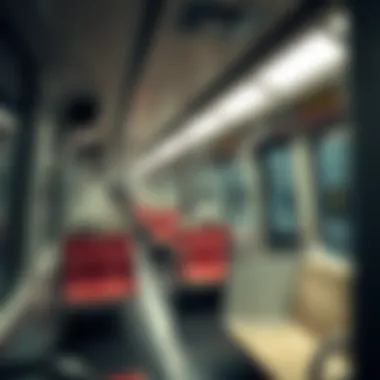
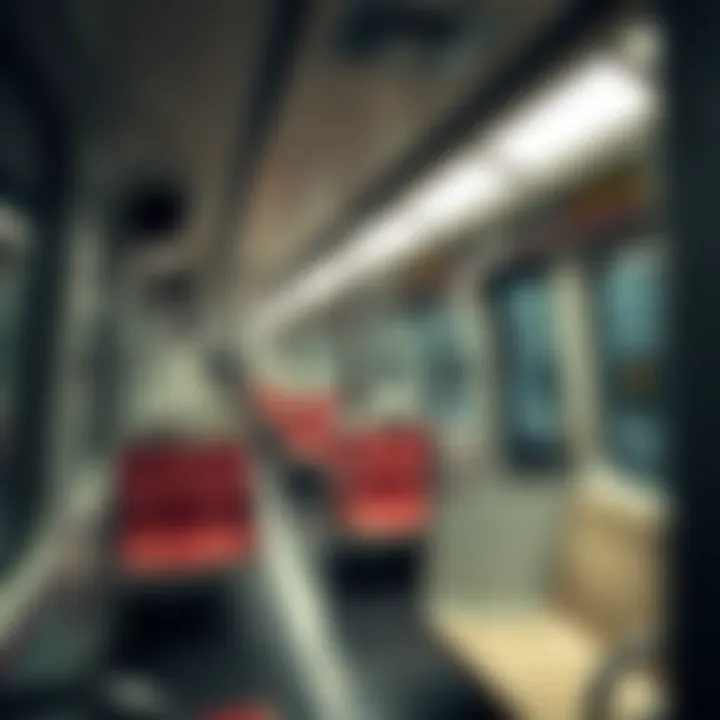
- Advantages of Investing Near Metro Stations:
- Increased demand for rental properties.
- Potential for high capital appreciation.
- Attraction of international tenants who prefer convenient transport options.
In contrast, areas without metro accessibility may struggle to keep pace with property valuation increases, making them less attractive to investors. The connection between the metro and property prices signifies that savvy investors pay close attention to upcoming metro expansions and new stations to capitalize on expected increases in demand.
Proximity to Metro Stations
The old saying goes, "Location, location, location." In the realm of real estate, proximity to metro stations stands as a formidable pillar supporting property value. As Dubai's urban landscape continues to evolve, the metro becomes a critical deciding factor for many would-be homeowners. Being just a stone's throw away from a station can mean life becomes a lot easier—commutes are shorter, and daily travel lives up to its promise of efficiency.
Living near a metro station means residents enjoy a host of benefits, such as:
- Shorter travel times for daily commutes.
- Access to a more extensive range of amenities without relying on cars.
- Lower transportation costs and reduced dependency on taxis or personal vehicles.
In recent years, developers have recognized this growing trend and are increasingly focusing on real estate projects near existing or planned metro stations. For example, residential complexes like The One at JLT have gained traction because of their closeness to the metro, directly influencing tenant interest and property sales.
It's not just about where you live; it's about how accessible your life becomes.
The positive correlation between the proximity to metro stations and increasing property values highlights an essential consideration for investors. As Dubai's metro network continues to expand, so too does the opportunity for growth in areas adjacent to those developments, making it a treasure trove of potential for those looking to invest thoughtfully in real estate.
Future Developments and Expansions
The future of the Dubai Metro is a topic that resonates deeply within the realms of urban planning and real estate development. This system, already a critical component of the emirate's transportation infrastructure, is poised for significant growth. The implications of these advancements are far-reaching, influencing everyday commuters and shaping the very landscapes of Dubai's neighborhoods.
Upcoming Stations
In the coming years, Dubai is set to unveil several new metro stations that will expand the existing network. Key additions include the stations along the Blue Line, which are anticipated to serve areas like Al Jaddaf and Dubai Creek Harbour. This expansion is not just about increasing the number of stations but enhancing accessibility for residents and visitors alike.
With these developments, it's important to note how each station plays a part in the overall scheme of connectivity:
- Al Jaddaf Station: A critical link for residents and those heading to the Dubai Healthcare City.
- Dubai Creek Harbour Station: Essential for future growth, this station aims to enhance the potential for tourism and local business.
- Meydan Station: This would connect urbanites to the Meydan Racecourse and surrounding residential developments.
By augmenting current transit options, these stations promise to alleviate traffic congestion while also promoting a more sustainable way of living. The strategic locations of these stops are sure to ramp up property values in their vicinity, aligning with Dubai's trajectory of continual growth.
Impact on Urban Expansion
The ripple effect of these metro expansions cannot be understated. As new stations come into play, they often herald a wave of urban expansion that essentially redefines the city.
Consider the effects on urban planning:
- Infrastructure Growth: Construction of roads, shopping districts, and housing developments tend to follow new transit lines.
- Economic Stimulation: More accessible areas attract businesses, innovating job creation and bolstering local economies.
- Sociocultural Shifts: Enhanced metro connectivity diversifies the population's movement across the city, fostering cultural exchange and communal synergy.
As a clear testimony to this phenomenon, past metro extensions have already sparked new residential and commercial hubs across various neighborhoods. With each new venture, Dubai reinforces its commitment to maintaining a transportation system that aligns with global standards.
Challenges Facing the Metro System
Navigating the complexities of the Dubai Metro isn’t solely about knowing the routes and station names. The system is an essential part of urban life, but like any extensive transport network, it faces challenges that can affect both its users and operations. Understanding these challenges is crucial for investors, residents, and city planners looking to optimize urban mobility and ensure safety.
Operational Efficiency Issues
The Dubai Metro is known for its slick operations, but maintaining that high standard demands constant vigilance. One major concern is operational efficiency. With a growing population and increasing ridership, the rail system can become congested during peak hours. While timetables may be optimized during non-peak times, there's a different story when thousands of commuters flood the stations in the morning.
- In peak hours, the waiting times can stretch, leading to frustration among daily commuters.
- Additionally, any unplanned disruptions due to technical issues or scheduled maintenance can throw the entire system into disarray, exacerbating delays.
Focusing on predictive maintenance technology can help mitigate some of these issues. By analyzing data from train sensors, potential problems can be identified before they escalate into major failures. This advancement could improve reliability and ensure that the metro continues to serve the public efficiently.
Public Safety and Maintenance
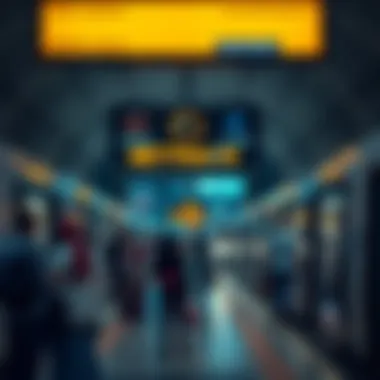

With operational efficiency is linked to public safety; that’s a no-brainer. A major challenge facing the Dubai Metro system is ensuring the safety and security of passengers. While incidents are rare, awareness and vigilance remain paramount. Periodic reviews and updates of safety protocols can help ensure that the system meets high security standards.
Furthermore, regular inspections and maintenance of both the trains and the stations are crucial. The unique climate of Dubai, with its extreme heat and dust, can wreak havoc on transit infrastructure.
- If safety measures are not properly followed, it can lead to accidents.
- Moreover, maintaining cleanliness and sanitary conditions in stations is vital to assure passenger comfort and health.
"Transport systems are mirrors of a city's soul. If the mirror is cracked, the image it reflects will never be clear."
Investing in technology to support real-time monitoring for emergency situations or potential hazards would significantly enhance the overall safety of the commuters using the metro. Furthermore, regular training and drills for staff can enhance their responsiveness during critical situations.
User Experiences and Commuter Insights
Understanding user experiences and commuter insights is crucial for both the operational enhancement of the Dubai Metro and for potential investors who seek to understand the market dynamics surrounding urban transit. By focusing on personal accounts and specific elements of the commuter experience, one can glean the advantages and pitfalls of the system. This awareness can notably shape strategies in real estate and urban planning, offering a clearer picture of how transit affects livability in Dubai.
Daily Commuters' Perspectives
For many Dubai residents, the metro is the lifeline that ties their daily routines together. Daily commuters rely on the system not just for convenience but also affordability. The cost-effectiveness of the metro, compared to the rising expenses of fuel and parking, makes it an attractive option.
Interestingly, commuters find solace in the predictability of the metro schedule. Unlike the unpredictable nature of traffic, the metro allows users to plan their commutes with a fair degree of certainty. This is especially important for those juggling work schedules and personal commitments. It's not merely a matter of getting from point A to point B; it’s about carving out time for oneself and managing life’s demands efficiently.
From my perspective talking with regular users, it’s clear they appreciate certain features:
- Cleanliness: The stations and trains are maintained well, and this reflects positively on the overall experience.
- Safety: Most commuters express a deep sense of security while traveling on the metro.
- Convenience: Easy access to key areas, whether it's for work, shopping, or recreation.
However, some commuters raise concerns about peak hour overcrowding. There are times when trains are packed like sardines, making the journey uncomfortable. A balanced viewpoint can help stakeholders consider necessary adjustments.
Visitor Experiences
Visitor perspectives on the Dubai Metro often differ from those of daily users. Tourists frequently utilize the metro to hop between attractions, experiencing it as an essential tool for exploring the city. Their insights tend to spiral around two facets: the clarity of the system and its accessibility.
First-time users often find the signage and announcements straightforward, which helps demystify what could otherwise feel like a daunting transport network in a foreign city. This is critical for Dubai’s image as a global tourist destination. Notably, the availability of maps and friendly staff assists in navigating the system efficiently, allowing tourists to offer praise on platforms such as TripAdvisor and Reddit. However, this doesn’t mean it’s all roses; some visitors have expressed confusion over ticketing systems, especially when using Nol cards for the first time.
For tourists, a few key insights emerged:
- Affordability: Many note that using the metro is significantly cheaper than relying on taxis for the duration of their stay.
- Connection to Landmarks: The ease of access to popular spots via the metro lends itself to a more enriching experience in the city.
Overall, user experiences vary between residents and visitors, but bridging their feedback can provide valuable insights that lead to optimization. By addressing concerns and enhancing positive features, the Dubai Metro can continue to flourish both as a daily utility and a tourist gem.
“Public transport isn't just a service; it's a statement about how a city values its people.”
For more information on urban transit and related user experiences, you may find insights on platforms like reddit.com or Wikipedia.
Finale and Future Outlook
The exploration of the Dubai Metro system reveals its increasing importance as not just a mode of transportation but as a crucial element in the urban fabric of Dubai. As the city continues to expand and attract global attention, the metro offers a glimpse into an efficient and sustainable urban transit method. The intricate planning and dedication behind its operations reflect a commitment to a thriving metropolitan lifestyle that prioritizes accessibility and efficiency.
Summarizing Key Points
Throughout this article, several pivotal aspects of the Dubai Metro have been highlighted:
- Integration into Urban Planning: The metro serves as a backbone for planning developments, seamlessly connecting residents and visitors to key areas of the city. This enhances not only mobility but also the overall appeal of Dubai as an attractive place for investment and residence.
- Impact on Property Markets: Proximity to metro stations has been shown to significantly influence property values. As the metro enhances accessibility, neighborhoods near stations often experience a boost in demand, making them prime locations for both living and investing.
- User Insights: The experiences of daily commuters and visitors provide a unique perspective, showcasing the metro's role in everyday life. Feedback highlights areas of efficiency as well as potential improvements for the overall experience.
- Future Expansion Plans: With ongoing expansions, the metro is set to enhance its reach, further positioning Dubai as a forward-thinking city. This expansion will likely correlate with increased land development opportunities and elevated property markets.
Looking Ahead
As we gaze into the future of the Dubai Metro, several noteworthy trends and predictions emerge:
- Technological Advancements: As global technology evolves, the Dubai Metro may adopt advanced systems for ticketing, train operations, and maintenance. Innovations, such as automated systems and AI integration, could greatly enhance operational efficiency and commuter experience.
- Sustainability Goals: With environmental concerns on the rise, the metro is likely to lead the way in promoting sustainable transport options. Developments in eco-friendly trains and renewable energy usage could solidify its status as a leader in public transportation.
- Increased Connectivity: As plans for expansion unfold, the metro will evolve to connect even more areas, making it an even more vital player in Dubai’s public transport system. The integration of the metro with other modes of transport, like buses and taxis, will foster a more comprehensive transit experience.
- Enhanced Commuter Experience: Future strategies might focus on improving passenger comfort by adding amenities, real-time updates, and enhanced safety measures. These adjustments would not only increase daily ridership but also make the experience considerably more enjoyable for both residents and tourists alike.
In summary, the Dubai Metro stands as a testimony to the city’s growth and ambition. Both current and future developments indicate a promising trajectory that reinforces its role as a critical infrastructure component for Dubai, making it essential for anyone considering life or investment in this remarkable city.
"The future is not something we enter. The future is something we create." — Leonard I. Sweet
For more insights on urban transport systems globally, visit Wikipedia or explore discussions on Reddit.











